

Unkover your competitors’ Marketing Secrets
Say goodbye to wasting hours on competitor analysis by equipping your team with an AI-driven, always-on competitive intelligence platform.


Say goodbye to wasting hours on competitor analysis by equipping your team with an AI-driven, always-on competitive intelligence platform.

Stay Ahead with AI-DRIVEN Competitive Intelligence
Unkover is your AI-driven Competitive Intelligence team delivering critical updates about your competitors the moment they happen:
Track your competitors website changes
Why spend all day stalking the competition when you don’t have to?
With Unkover, you’ll know instantly when your competitors tweak their messaging or shake up their pricing. No more endless scrolling through their sites or second-guessing your strategies.
Let us do the heavy lifting for you, ensuring you’re always in the loop by notifying you the moment a critical change happens on your competitor’s pages.
Sit back, relax, and keep winning—Unkover makes sure you’re not just in the game, you’re always a step ahead.


Read your competitors emails
Companies love updating their customers and prospects about relevant news, product updates, and special offers.
That juicy info from your competitors? It’s yours too. Unkover will automatically capture all their emails and bring them right to your doorstep—accessible to your entire team, anytime.
[COMING SOON: Our fine-tuned AI will sift through these emails, extract key information and send them over to the best team within your org. Less noise, more signal!]
We hear you! Unkover’s goal is not to flood you with tons of data points that no one in your team will ever read. We gather competitive intelligence from thousands of data sources and use AI to highlight actionable information to the right team in your company.
Say goodbye to noise. We’re 100% signal.
ROADMAP
We’re excited to get Unkover in your hands as soon as possible and keep building the best competitive intelligence tool with your precious feedback. The roadmap for the next few months is already exciting, so take a look!
While we build and deliver, here’s our promise to you: as an early tester and customer, you’ll lock in an exclusive bargain price we’ll never offer again in the future.

Spy on your competitors’ full marketing strategy: social, ads, content marketing, email flows, and more.

Track competitive Win/Loss analysis and build battle cards. Get alerted at every pricing change.

Get immediate alerts when competitors announce new features or major releases. Identify strengths and weaknesses from online reviews.

Get the competitive intelligence you need where you need it: Slack, eMail, MS Teams, Salesforce, Hubspot, Pipedrive and more.
slack integration
Unkover’s Slack integration lets you keep your whole team up to speed with your competitors’ updates.

Join now to lock in an exclusive 50% lifetime discount
For startups and small teams, it’s the essential toolkit you need to keep an eye on a select few competitors.

Up to 5 competitors

50 pages monitored

10 email workflows

3-day data refresh
$39
/per month
$ 79
50% discount
Billed annually
For growing businesses, it allows you to monitor more competitors, pages, and email workflows.

Up to 10 competitors

100 pages monitored

20 email workflows

1-day data refresh
$79
/per month
$ 159
50% discount
Billed annually
For large companies, it is tailored to meet the needs of multiple teams needing granular insights.

Custom number of competitors

Custom number of pages monitored

Custom number of email workflows

Hourly data refresh
Custom price
Billed annually

Here at Breadcrumbs, we eat, sleep, and breathe lead scoring criteria. Every day, we analyze and dissect what works and what doesn’t when it comes to scoring leads. And now, we’re here to share our insights with you.
In this article, we’re taking things up a notch. We’re going to reveal the top lead scoring criteria you can start using today–they’re fewer than you think, but they have a proven track record of having high impact. By implementing them, you can increase your conversion rates and boost revenue acceleration.
So, fasten your seatbelts and get ready to take your lead scoring models to the next level. This 2023 update is your ultimate guide to the six lead scoring criteria that will boost your revenue.
Let’s dive right in!
As far as the definition of lead scoring goes,
Lead scoring is a method used by businesses to evaluate and rank the potential of leads based on their behavior, demographics, and engagement with the company. It helps prioritize leads, identify qualified prospects, and allocate resources effectively for higher conversion rates.
Let’s put some of this theory into practice and see whether lead scoring is for you. That’s an easy-to-answer question. It all comes down to this: Is your company experiencing one (or more) of these issues?
If any of this looks familiar to your company–or at least one of the points above–then lead scoring is definitely for you. When setting up a lead scoring system, you’ll be able to:
Watch what our customers say
“Life before Breadcrumbs was, I think you could call it the Dark Ages. We started with an SLA of two days to a week sometimes. And we’re getting within the 10 to 5-minute mark. So that’s so exciting for us.”

Christie Horsman, VP of Marketing, Thinkific
Ready to close more deals faster and accelerate your company’s growth? In the next section, we’ll see the key lead scoring criteria you need to build an effective lead scoring system.
Pro-tip: A lead scoring strategy can be more challenging the more sophisticated it gets. At Breadcrumbs, we'll recommend the perfect lead scoring matrix for your business and then help you identify your top prospects as they move through the sales funnel. You'd just need to connect to your data sources (such as HubSpot, Salesforce, Segment, and many others), answer a few questions, and start getting more leads!
RFM analysis is a powerful technique businesses use to understand their customers that you can apply to B2B lead scoring. RFM looks at three important things.
First, it checks how recently customers have interacted or made a purchase. Then, it looks at how often they engage with the business. Lastly, it measures how much they’ve spent. By analyzing these aspects, you can improve marketing strategies and overall performance.
Using RFM analysis helps answer important questions about your customers, like who aligns best with your business, which customers don’t fit your target market, and the key metrics for high-quality customers. You can even apply parts of the RFM model to assess leads who haven’t made a purchase yet.
For instance, you can analyze how recently customers signed up for a free trial or demo, how often they engage with your emails or marketing messages, and what valuable actions they take, such as daily trial usage or scheduling sales or onboarding calls. These indicators give insights into their potential value as future clients.
When applying RFM analysis to lead scoring, it’s crucial to consider both recency and frequency by examining how recently leads have interacted and how often they engage with your business, allowing you to assess their potential value and prioritize your efforts accordingly.
Let’s see this in more detail:
As we have seen, it is crucial to know how recently your prospects have interacted with your company.
In this sense, recency allows you to evaluate and prioritize activities that are happening right at this very moment.
You may argue that having the historical context of what a customer has done in the past is important as it helps to build the story of who they are.
This is undoubtedly true, but when it comes to following up, you want to interact with your customers who are active right now and allow the historical data to help you shape the conversation with your prospects.
Lead scoring is the method of assigning points to contacts or potential prospects based on…
BANT is an acronym that stands for Budget, Authority, Need, and Timeline. It is a…
Lead qualification is a systematic process utilized by businesses to evaluate potential customers based on…
Another important indicator that will help you prioritize your contacts is frequency. Broadly speaking, it means you can count how many times they raise their hand at what you propose.
No actions are created equals, of course–and we’ll see it shortly–but you can definitely infer a stronger interest in a prospect that repeats an action in a short period of time.
For example, if a customer is continuously coming to your website and viewing 2-3 pages at a time for the course of a week, that should be a big signal that they are interested in learning more about your products and/or services.
This can be the perfect time to reach out–and offer more value.
Traditionally, time decay in lead scoring refers to the gradual decrease in the score value of a scoring model. When you score leads for acquisition, time decay recognizes that the value of actions taken by leads diminishes over time.
Let’s break it down with an example: Imagine a lead who downloaded your ebook today versus another lead who downloaded it a month ago. The lead from today’s download is showing immediate interest and engagement, while the one from a month ago might have already moved on or lost interest.
Therefore, giving more weight to recent actions helps you focus on the most active and engaged leads, increasing the efficiency of your lead scoring process.
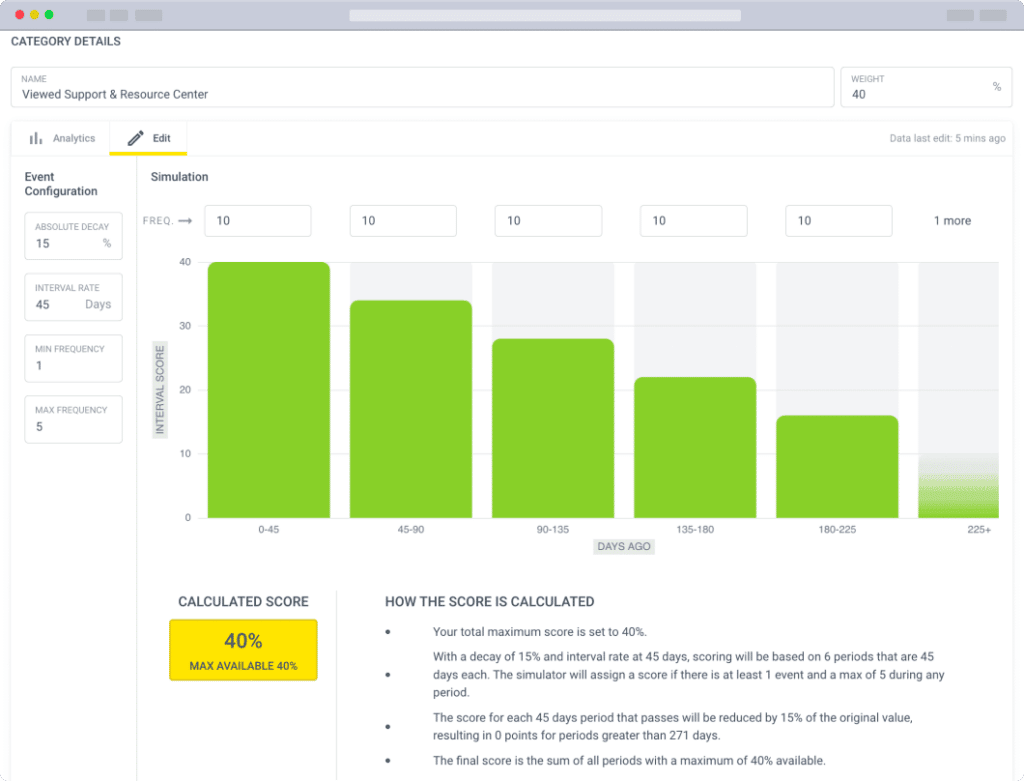
But it doesn’t stop there.
Think about disengaged customers. They are not doing the action you want (i.e., they’re not logging in to your app or not using the key features of your product), and you need to know that sooner rather than later to avoid them becoming at risk or even churning on you.
Whether time decay is a positive or a negative indicator, it’s crucial to incorporate it into your scoring model to prioritize leads and customers that need your attention right now.
Many lead scoring tools only consider either recency or frequency data, but not both. At Breadcrumbs, we take a different approach. We consider both fit and activity, measuring all actions with frequency and recency in mind. This enables us to provide accurate scores for any user at any given time.
We have set the table with recency, frequency, and time decay. Now, it’s time to serve the main course: the best lead scoring criteria you can use right now to implement lead scoring and boost your revenue.
But first, a word of caution: Every company is different, and even if we swear by these six lead scoring criteria, your best bet is always to rely on your data.
I know. You think your data is bad or chaotic if you’re being optimistic. Truth is, data is never perfect, and you need a few data points to have an impact, actually.
A quick (and free) way to prove it is to run a Breadcrumbs Reveal analysis. It just takes three steps:
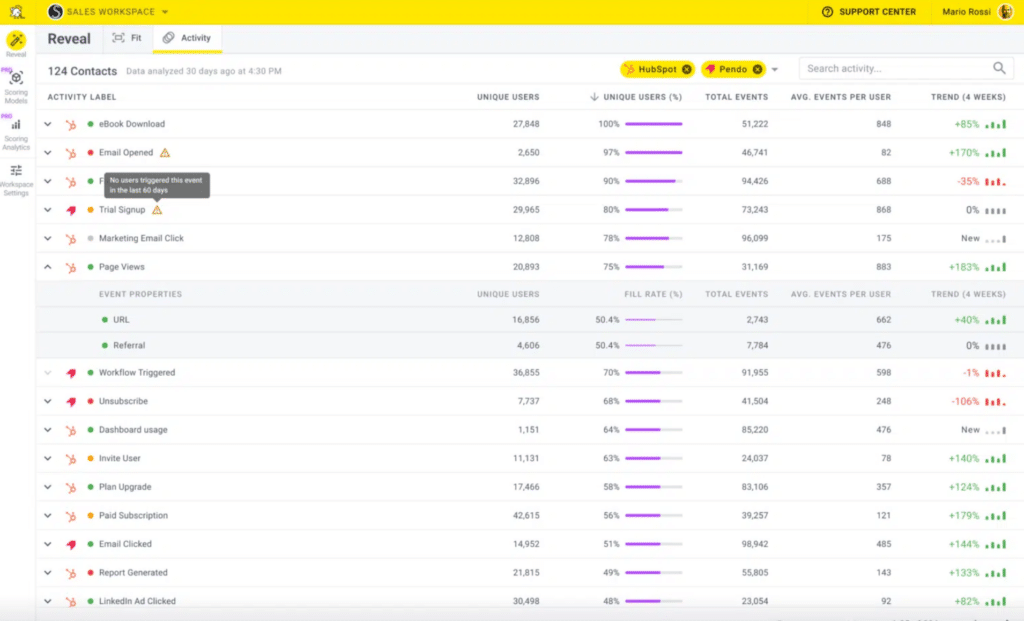
Get started for free now, or get a demo to learn more.
We’ve run this analysis thousands of times over the last three years, and we have seen some patterns emerge. So, without further ado, here are the six best attributes for getting more qualified leads for your sales team.
Company size (and revenue) is an important factor to take into consideration when setting up your lead scoring system.
This goes back to your ideal customer profile: Depending on the segment you’re marketing to, be it B2B or B2C, larger organizations, or SMBs, you may want to adjust your scoring system to prioritize leads with certain company sizes/revenues.
If you’re targeting smaller businesses, you’ll want to focus on leads that are SaaS startups with a lower company size. If you’re targeting larger organizations, you’ll likely need to look at companies with more extensive financials.
Among our lead scoring criteria, the job title may be the less intuitive one. However, collecting and scoring job titles correctly can go a long way in ensuring you are talking with the right person.
While–of course–the ideal conversation your sales team may have is the ultimate decision-maker, it is crucial to identify people within the company who may have the authority to push the opportunity and conversations forward.
Scoring job titles correctly will help your sales team shape that conversation–push the deal forward and overcome any customer objections with the right person.
Pro-tip: When you start scoring on job title, make sure you account for the different variations of that title that someone could provide (as an example, they may report Vice President, Senior Vice President, and so on)–this will help ensure you are rewarding a job-title score appropriately.

Salesforce is one of the most high-powered sales and CRM-focused SaaS tools on the market…
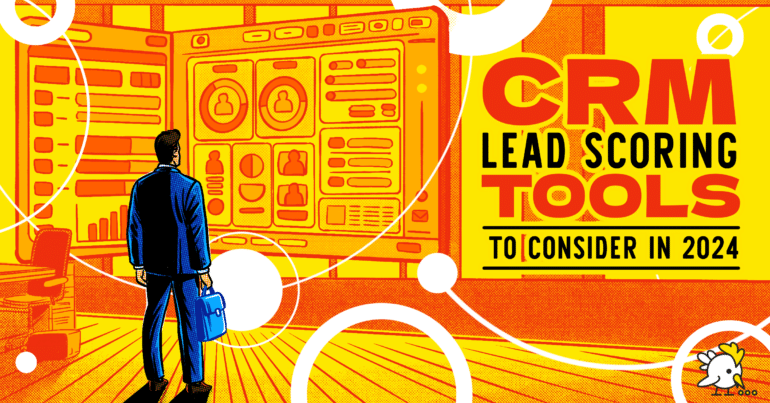
Every good sales team needs a great customer relationship management (CRM) tool backing them up. …
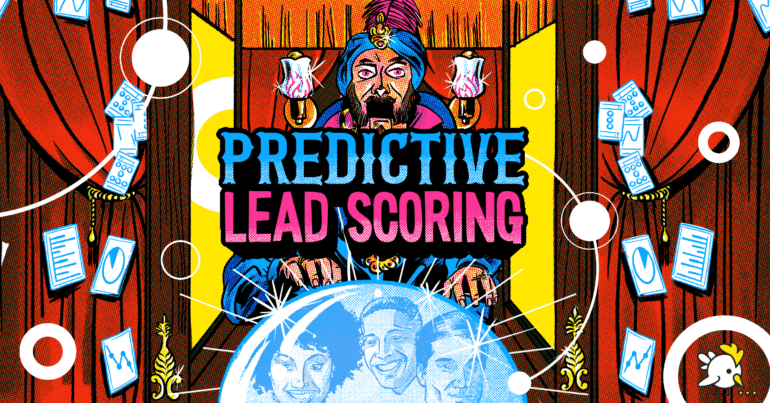
Over the past decade, we’re sure that you’ve noticed that your marketing tech stack options…
Much like job titles, industry helps with aligning your product and/or service fit to companies that have shown success.
What if you could spot new opportunities by looking at how your team handled similar – successful or unsuccessful–cases in the past? That’s exactly what the mapping and ranking industry is in your lead scoring system.
How to do it? You can better understand this (and learn from your mistakes) by looking at your customer base (or past opportunities) to see if there is a correlation between closed-won opportunities and successful customers.
Pro-tip: There are many ways you can do so, for example, through advocacy and renewals. Ask yourself (and the customer) what you did right and what you could have done better. You’ll learn loads, trust me.
It is often said that actions speak louder than words, and that rings true for lead scoring as well. This is why next, on our lead scoring criteria review, we find activities.
All in all, online and offline activities help to identify what someone is interested in and how they like to consume their information. This is gold information for you–both in terms of being able to reach back to them with the right content and create that content in the first place.
A well-rounded lead scoring model can–and should–accommodate all the sources of where you collect information, including (but not limited to) your MAP, CRM, trade shows, ads, and social promotion.
Here’s where frequency, recency, and time decay step in to make all the difference between an okay lead scoring system and a great one.
Most lead scoring systems would just add, let’s say, two points every time a visitor hits your product page. However, what also matters here is combining the actual hit with the following information:
You want to differentiate between:
[Ideal lead] Visited your page once today and three times over the last week.
[Poor quality leads] Visited your page for the last time one month ago and three times over the last year.
You need more of those better leads that are engaging right now, and adding recency, frequency, and time decay into the equation enables that.
Pro-tip: When you collect information from different sources, make sure you standardize your lead capture. This will allow you to ensure the quality of the data you are putting in your lead scoring system and have automation that actually works–and makes your life easier.
Similarly to website page visits, every time users engage with the emails your email marketing team crafted, they should be awarded a higher lead score.
When a user engages with your emails, it indicates a higher level of interest in your product. Either by opening the email, clicking on links within the email, replying to the email, or even forwarding it to others. Each of these actions indicates intent.
For this lead scoring criterion, frequency, recency, and time decay also apply: Users who click a link on your emails today should rank higher in your point values system as they are engaging right now.
Lead source is super important: People downloading your lead magnet or registering to your product’s freemium or free trial version via a dedicated landing page usually have higher conversion rates and should definitely be on the good side of your lead scoring point threshold.
Again, in this case, if you apply frequency and recency of action, you can surface more leads that are engaging with your content right now.
Once you have your lead scoring criteria, it’s time to build your lead scoring process. We may be biased, but we believe that, by using Breadcrumbs, you’ll not only score leads quickly and effectively, but you’ll also improve your marketing and sales teams’ efficiency and results.
Don’t take our word for it; see how Thinkific doubled their MQL to OPP rate and reduced their SLA by 99.9% when using Breadcrumbs.
Want to replicate what Thinkific did? It just takes four steps:
Run a Reveal analysis to uncover the best lead scoring criteria of your most important contacts. Instantly get valuable insights into their behaviors, identify potential sales opportunities, and make better business decisions.
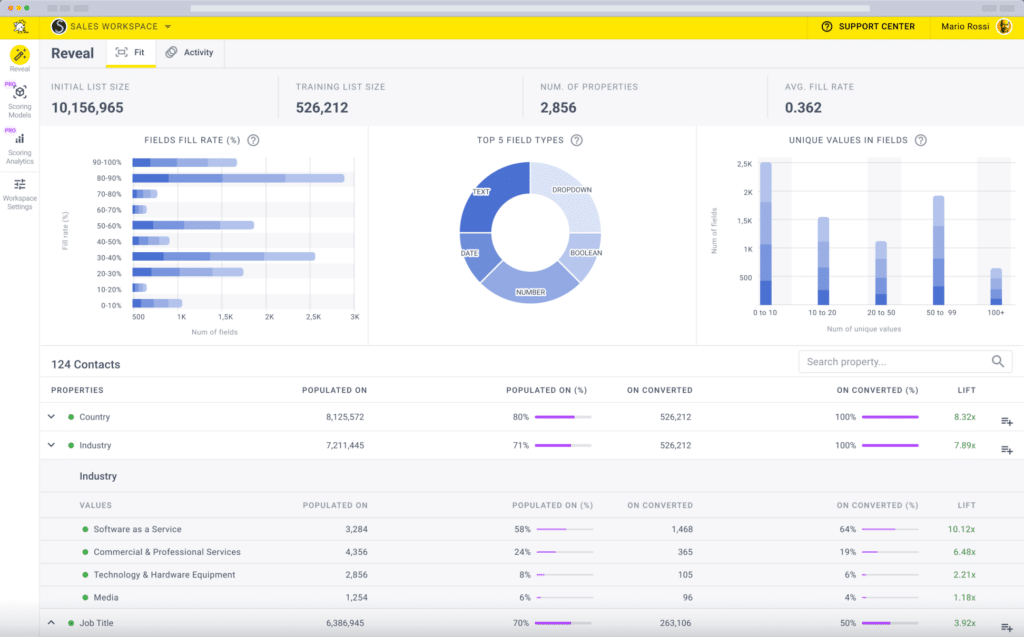
Using the results of your Reveal analysis, use Copilot to create your model. With just a few clicks, you can automatically build a personalized model while keeping full control over the process, including making changes as needed.
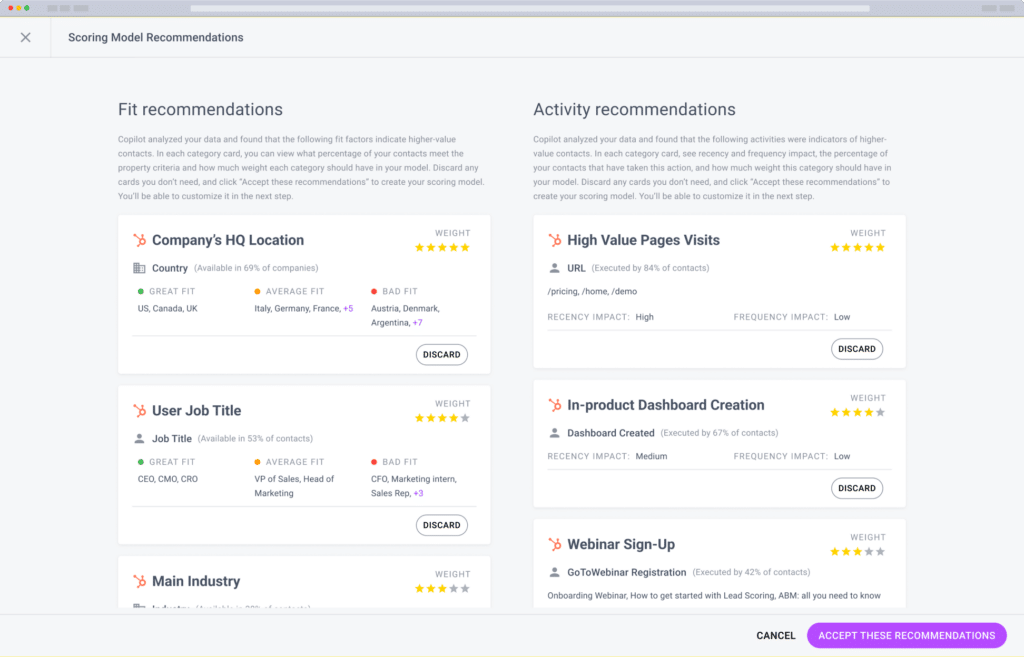
Expanding your options is essential when it comes to building models. With a tool that enables building multiple models and experimenting with different hypotheses, you can maximize your revenue sources to the fullest.
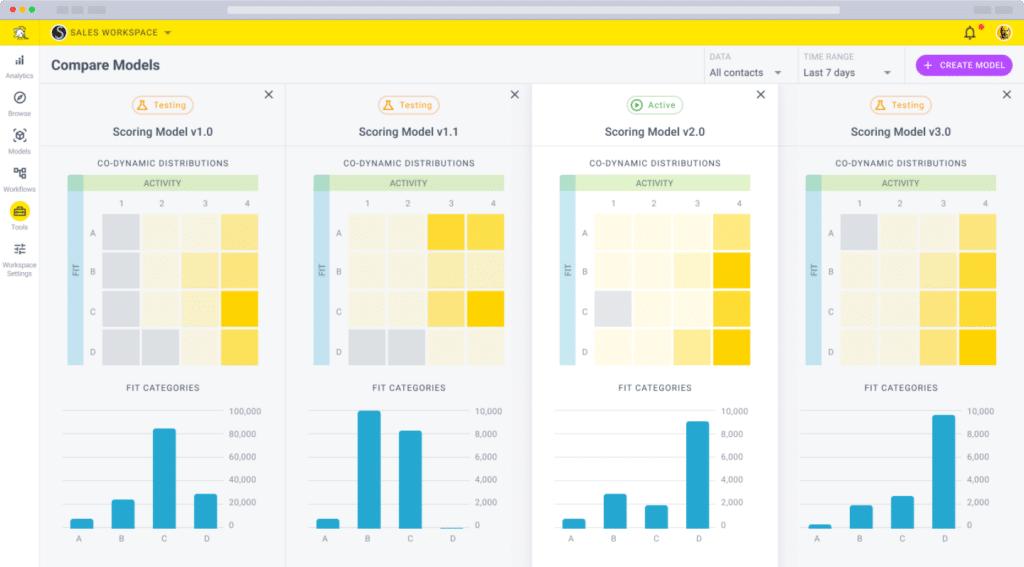
Explore is a powerful feature that allows you to understand your top contacts and what actions lead to conversions. You can filter, segment, sort, and view contacts from all your connected data sources to access the latest insights. It will enable you to analyze trends and identify actions that indicate intent and increase success rates with personalized experiences.
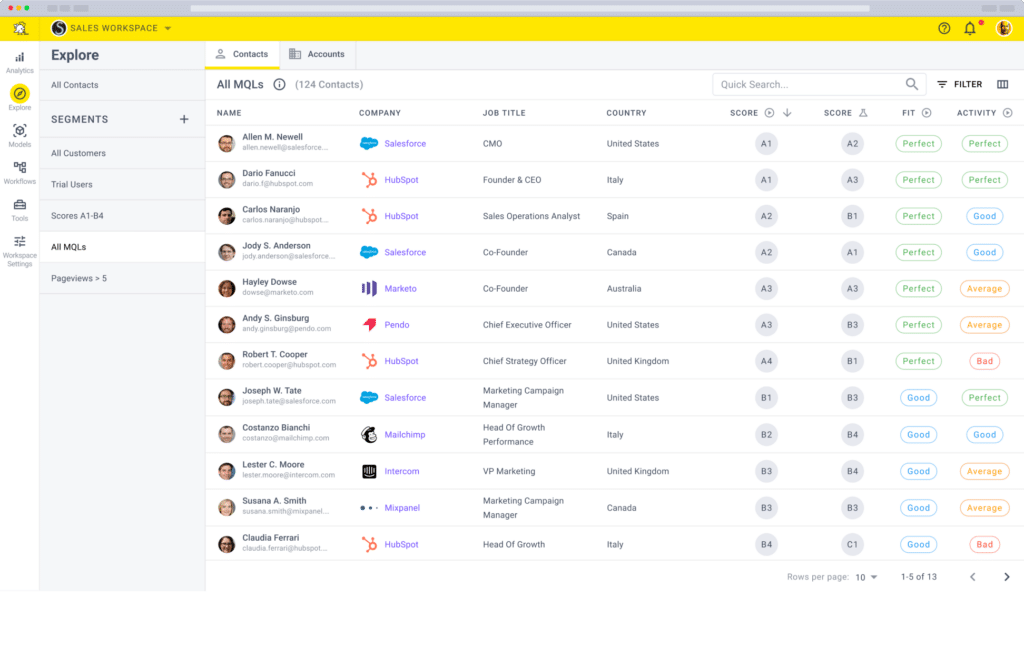
You’ve built your lead scoring matrix. You’ve qualified leads. You’ve got your leads scored. You’ve increased the conversion rate. Is it over?
The short answer is no, and this is actually a good thing because, with lead scoring, there’s always the opportunity to get more good leads, increase conversions, and lower acquisition costs.
As you’re assessing your lead scoring models, you’ll want to look at four different dimensions:
A great lead scoring model should positively impact all of these four aspects.
Start simple; maybe focus on Conversion or Value first–these metrics can quickly boost revenue by helping you uncover and nurture high-quality leads.
Experiment with A/B testing (a built-in feature at Breadcrumbs for this exact reason) to see how tweaks to your model affect the customer journey and results–like adding a data point that lets you upsell effectively.
Once you’ve nailed one objective, move on to the next, always ensuring you’re keeping up with previous goals. It’s all about trial, error, and continuous improvement!
Want to see how it works? Our revenue experts will be happy to discuss what Breadcrumbs can do for you! Book a demo today.
Prioritizing your leads correctly and ensuring the quality of the data you collect on your prospective customers is vital to increasing conversions, shortening the sales cycle, aligning your marketing and sales team, creating content that fits with your higher-converting customers, and ultimately boosting your company’s growth.
In this post, we have shared six tried and tested lead scoring criteria that you can implement today to get started with ranking leads and accelerate your company’s growth.
And now, back to you: Which are the best lead scoring criteria you’ve used in the past that are not mentioned in this article? Write them down in the comments below!
Lead scoring is a process that involves ranking your leads to define their value to your company.
Think of lead scoring as a prioritization engine: When you have a lead scoring process in place, your sales team will instantly know which leads to follow up with first, as they are more likely to convert.
No two leads are exactly the same (even if they may look identical.) This is where lead scoring comes into play and helps to surface these differences so sales reps understand better who they will be communicating with and whether they should have that conversation at all.
Lead scoring clients involves using specific lead scoring criteria to evaluate and prioritize potential leads. These criteria typically include factors such as demographic data, lead’s behavior, engagement level, and fit with your ideal customer profile.
By analyzing these factors, you can assign a score to each lead, helping them identify the most promising prospects. This approach enables you to focus your efforts on leads with the highest likelihood of conversion, optimizing your sales and marketing strategy.
You can calculate the lead score by assigning a value to each potential lead based on various criteria and factors. Each criterion is assigned a weight to indicate its importance in determining lead quality.
A tool like Breadcrumbs, which uses a co-dynamic system and incorporates frequency, recency, and time decay into the equation, allows for laser-focused scores that can help you prioritize leads and allocate sales and marketing resources accordingly.
A lead scoring model is a system used by businesses to evaluate and rank potential prospects based on their likelihood of becoming customers.
It assigns a score to each lead based on lead scoring criteria such as demographic information, online behavior, and engagement with marketing efforts.
This helps you prioritize and focus your efforts on sales-ready leads, improving efficiency and conversion rates.
A good lead score represents a lead that shows strong potential to convert into a customer. It typically indicates that the lead has demonstrated high levels of engagement, fits your ideal customer profile, and aligns with the desired behaviors and characteristics.
However, it’s important to note that what constitutes a good lead score may differ from one organization to another and should be defined based on the unique needs and objectives of the business.
This is why scoring leads should be based on sales and marketing alignment and real data points. Tools like Breadcrumbs and Reveal can assist you in identifying the right lead scoring criteria you need to create high-performing lead scoring models surfacing high-quality leads.

Based on our vast experience in lead scoring, we have observed an interesting trend.
When using a co-dynamic distribution approach, a well-optimized model performing at its best has approximately 5-15% of the contacts in the top-left quadrant of the distribution chart.
This particular quadrant represents users who not only align closely with your ideal customer profile but also exhibit a remarkable level of engagement and activity.
I’ve been struggling with finding the right lead scoring criteria for my company and stumbled in your article. Thanks for the detailed list of the top criteria to use – sometimes it can be tricky but it’s important to prioritize the ones that can make the biggest impact.
Great review of the top lead scoring criteria! Actually missing a couple of those and will be implementing soon.